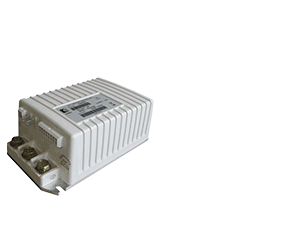A to B suggests incremental gains in new market development. A to Z suggests the product has left the starting block and is on its way to broad market expansion. In this case the product is a driverless delivery vehicle. The brand and model focused on in this article is the Nuro R2, pictured below.
I have mentioned this vehicle in previous columns in analyzing the future course of urban/suburban mobility (USM) market. In those articles I made the point that small, electric vehicles would transform the system of transport in the context of a dispersed living lifestyle. Golf car-type vehicles are likely to play a role in this transformation.
Nuro receives authorization for fully driverless trials
The U.S. Department of Transportation in February 2020, under Elaine Chao, granted Nuro an exemption from certain on-road vehicle requirements, such side mirrors, rear visibility, and a windshield that can be seen through.
None of these accessories are needed because of the vehicles robust system of sensors and the simple fact that there is no driver to make use of them. The exemption also permits the Nuro R2 to operate its rearview cameras while moving forward, since the vehicle will never be occupied by a human driver who could be distracted by the rear video display.
In addition to the Federal exemption, Nuro has received authorization from the California DMV to undertake trial runs in at least nine northern California cities. The company is also undertaking pilot projects in Houston, TX and Scottsdale, AZ.
Nuro specs: Here is a list of specifications for the Nuro:
While certain cities are hosting the Nuro in trials—and anticipating the eventual introduction of commercial fleets to be used by grocery chains and last mile delivery companies such as FedEx, UPS, and Amazon, these very same cities are undergoing vast changes in the way they operate. The age of virtual reality and remote communication will bring on radical changes in urban design—and these changes will create a very welcoming environment for the Nuro and its competitive counterparts.
Dispersed living lifestyle is now an urban planning concept
The notion of living a dispersed living lifestyle in an urban environment seems contradictory, but urban planners are envisioning urban living designs that arguably bridge the apparent difference. The following are excerpts from an article for Bloomberg’s CityLab feature, with links to further information. Feargus O’Sullivan, a writer for CityLab, who focuses on European infrastructure, design, and urban governance, reports that, “One of the hottest ideas in urban planning was the “15-minute city.”
The 15-minute city is “…a vision for a decentralized urban area that allows residents to meet their daily needs within a quarter-hour walk or bike from their homes,” he notes, and, “the concept has been pursued as a means of cutting greenhouse emissions and boosting livability in a host of global cities.” — especially Paris, where Mayor Anne Hidalgo has embraced the model as a blueprint for the French capital’s post-Covid recovery.”
If the 15-minute walk-around is insufficiently small, the Swedes have come up with a one-minute city, concentrating at the single street level, and paying attention to what its designers call, “the space outside your front door — and that of your neighbors adjacent and opposite.”
Gated communities as forerunners of the brave, new world
If these concepts strike a chord in those of us in gated communities, they should. Within many gated communities are individual subdivisions, they with their own gates and amenities. We may have to traverse beyond the limits of a 15 or one-minute walk, which we can do in our PTVs, but notion of self-containment and neighborhoods is clearly quite similar. And, the typical gated community substantially predates these European visions.
All-in-all, however, whether European or American and regardless of history, the concept of a dispersed living lifestyle which we first wrote about over a year ago, has become a trend and is being implemented on a global scale in developed countries.
The logistical foundations for dispersed living
Certainly, one of the key features of dispersed living communities is the logistical support system that must evolve and be in place for the vision to become reality. Our gated communities have this figured out, with service streets for carriers to have access to the community’s stores, schools, and entertainment centers.
Nuro, a last mile delivery vehicle is now operating commercially in several locations. The outstanding feature of these vehicles is that they are autonomous, that is, driverless vehicles. Expect to see the Nuro in your gated community in the not-too-distant future, making deliveries to the four corners of the community, adding significantly to routine shopping convenience, and reducing traffic at the supermarket.
James Hill, the visionary behind the one-minute street notes that, “They [the neighborhood streets] are a filter and a portal to the wider world…” The words “filter” and “portal” are key and allude to the logistical support system that will be required. It is here where the Nuro plays a key role.
In addition to the Nuro, last mile delivery systems will become a growing and highly competitive market, featuring small vehicles from something like the Club Car 411, to e-cargo bikes that are being rolled out in tests across the country by DHL.
Stock market gains for small, electric vehicle companies
Here is an excerpt from a stock analyst report published in Seeking Alpha, entitled, “Electric Vehicles Race Higher…”:
Today’s broad auto rally includes gains from Chinese auto names and key suppliers, with Blink Charging (BLNK +10.0%), Ayro (AYRO +9.6%), XPeng (XPEV +5.3%), Nio Technologies (NIU +12.6%), Li Auto (LI +8.4%), Workhorse Group (WKHS +9.4%), Nio (NIO +6.7%), Nikola (NKLA +7.3%), Electrameccanica Vehicles (SOLO +5.0%), Lordstown Motors (RIDE +3.3%), Fisker (FSR +1.7%), Tenneco (TEN +8.6%), American Axle & Manufacturing (AXL +12.2%), Westport Fuel Systems (WPRT +6.4%) and Superior Industries (SUP +5.5%) all higher.
[It should be noted that Nuro successfully raised almost $1 billion in venture capital funds in February 2019 from Softbank Vision Fund.]
Aside from passing on these stock tips, across a broad spectrum of electric vehicle manufacturers and parts suppliers, if you look carefully in the above paragraph, you will see three companies I have mentioned in past articles, namely, Electrameecanica, Ayro, and, Nio Technologies.
All these companies are start-ups, produce small, electric vehicles, and are NASDAQ listed. The vehicles they produce could well begin to penetrate the market within gated communities, as well as in urban environments. For the consumer in the gated community and elsewhere, there will be a wider set of choices, beyond the traditional PTV, for accomplishing that all important objective of getting from point A to point B.




















